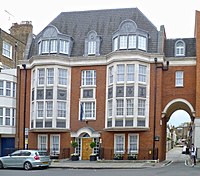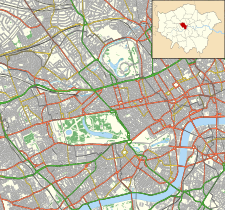King Edward VII's Hospital
| King Edward VII's Hospital | |
|---|---|
|
Hospital buildings in Beaumont Street (top) and Devonshire Street (below) | |
| Geography | |
| Location | Westminster, Greater London W1 United Kingdom |
| Coordinates | 51°31′15.3″N 0°9′1.5″W / 51.520917°N 0.150417°W |
| Organisation | |
| Care system | Private |
| Funding | Non-profit hospital |
| Type |
|
| Patron | Charles III |
| Services | |
| Emergency department | No |
| Beds | 56[2] |
| History | |
| Opened | 1899[3] |
| Links | |
| Website | Official website |
King Edward VII's Hospital (formal name: King Edward VII's Hospital Sister Agnes) is a private hospital located on Beaumont Street in the Marylebone district of central London.
Agnes Keyser, later known as Sister Agnes, established the hospital in her home at 17 Grosvenor Crescent in 1899 in the wake of the Second Boer War and at the suggestion of the Prince of Wales (later King Edward VII) who went on to become the hospital's patron. Its first intake of sick and mostly gunshot-wounded British Army officers arrived in February 1900.
The hospital continued to operate during peacetime. During the
In December 2012, the hospital received international media attention when, while
Foundation
The hospital was established in 1899, in the wake of the
The hospital, known simply as Sister Agnes's hospital, initially housed only 12 beds, a basic operating theatre and a staff of six carefully selected nurses, and admitted its first mostly gunshot wounded British Army officers in February 1900, a week after receiving a letter of gratitude from British Army officer General Evelyn Wood VC.[4]
-
Agnes Keyser as "Sister Agnes"
-
No.17 Grosvenor Crescent, the Keyser home and first King Edward VII's Hospital for Officers[7]
-
Original site of the hospital at 17 Grosvenor Crescent, now the Belgian Embassy
20th century
On the death of Queen Victoria in 1901, the Prince became King Edward VII and he subsequently became the hospital's first patron.[2][5] On 9 August 1901, in recognition of their services to the wounded from South Africa, the king conferred the Royal Red Cross to both sisters.[8] In 1904 the hospital was officially named King Edward VII's Hospital for Officers and continued to care for military officers during peacetime.[5] The King became the hospital council's president and remained so until his death in 1910.[9] That year, the hospital moved to 9 Grosvenor Gardens.[10][11] In the same year, eight years after retiring from the Indian Medical Service with the rank of honorary Colonel, Peter Freyer became a member of the honorary medical staff of the hospital, and remained there until 1909,[12][13] the same year in which the constitution of the hospital was modified.[14]
First World War
The hospital had 16 beds in 1914,
During the
Interwar
In 1930, the hospital was awarded a
Second World War
Prior to 1940, Sister Agnes had been matron.[9] In 1941 the interior of the building was badly damaged by bombing, and Sister Agnes died shortly afterwards.[6][25] Between September 1940 and October 1948, the hospital had been closed.[9]
Post-war
In 1948,
In 1962, the hospital became a
Margaret Dalglish became matron in 1969,
-
John Percy Lockhart-Mummery, who operated during the First World War.[7]
-
Sister Agnes in later life[7]
-
The patient's sitting room at 9 Grosvenor Gardens[7]
-
Queen Mary with Matron Saxby, Sir Harold Wernher and Sir George Ogilvie. 1948[7]
-
Queen Mary and Matron Saxby with the nursing staff (1948).[7]
21st century
The hospital works with the
In 2009, the year of the 40th anniversary of Prince Edward being president, the Michael Uren Foundation provided funds for a
The hospital has often been confused with the King Edward VII Hospital, Midhurst and the King's Fund.[42]
In December 2012, the hospital received international media attention when
Death of Sir Michael Harris Caine
On 7 February 1999 the businessman and Booker Prize founder Sir Michael Caine fell into a coma after staff were unable to clear a blocked breathing tube. He died five weeks later. A leading intensive care specialist concluded that the possibility of death would have been "minimal" had staff at the hospital received proper training.[46]
Sir Michael's widow, Baroness Emma Nicholson, claims that nurses refused to call consultants and doctors despite her husband's distress.[47] The Baroness also claimed that a subsequent operation on her husband took place at an NHS hospital because the King Edward VII "could not cope."[48] In September 1999 the Guardian reported that Baroness Nicholson was due to pursue legal action against the hospital alleging negligence.[49] In light of her husband's death, Baroness Nicholson said:
I find it repugnant that NHS beds should be used as a final resource by the private hospitals who set themselves up as being able to cope and yet demonstrably cannot. I don't see why the NHS resource should be leached away in this way.[49]
Notable patients
The hospital has been used by various members of the
In December 2013 it was announced that the hospital had received a donation of £30 million from the businessman, Michael Uren.[57] In October 2014 Zambian president Michael Sata died at the age of 77 at the hospital, after receiving treatment for an undisclosed illness.[58]
Office holders
Chief executives
Formerly known as the house governor.[9]
- Sir George Drummond Ogilvie (1938–1950)[9]
- Vere, Lady Birdwood (1950–1972)[9]
- K. B. Smith (1972–1985)[9]
- Commander I. K. Brooks (1985–1992)[9]
Others
- Lieutenant General Sir Bill Rollo[40]
- Sir Jameson Boyd Adams[59]
See also
References
- ^ a b c d Friend's Newsletter (PDF). King Edward VII's Hospital. 2018. pp. 5–6.
- ^ a b c "About Us". King Edward VII’s Hospital. Archived from the original on 24 November 2020. Retrieved 31 January 2021.
- ^ "Celebrating 120 Years". King Edward VII’s Hospital. Archived from the original on 24 November 2020. Retrieved 1 February 2021.
- ^ a b c Hough, 1998, pp.1-6
- ^ ISBN 978-1-84396-351-6.
- ^ PMID 1297078.
- ^ a b c d e f Hough, 1998, pp.118-119
- ^ Hough, 1998, p.20-21
- ^ a b c d e f g h i j k l m n o p Hough, 1998, pp.183-184
- ISBN 978-1-4050-4924-5.
- PMID 29817157.
- PMID 24865238.
- NUI Galway. Reference code P57.
- PMC 2318043.
- ^ a b King Edward VII's Hospital for Officers (Sister Agnes). Historical Record 1899-1969 (3rd ed.). London: Beaumont House. 1969.
- ^ a b c Hough, 1998, p.48
- ^ Cloete, Stuart (1972) A Victorian Son, an autobiography, 1897-1922.
- ISBN 978-1-77609-073-0.
- ^ Supermac. Author: D.R. Thorpe. Publisher: Chatto & Windus. Published: 9 September 2010. Retrieved: 1 February 2014.
- ISBN 978-0850523393.
- ISBN 978-0-7190-6974-1.
- ISBN 978-1-909881-00-6.
- ^ "King Edward VII'S hospital Sister Agnes- Charity 208944". register-of-charities.charitycommission.gov.uk. Archived from the original on 6 February 2021. Retrieved 6 February 2021.
- ^ Hough, 1998, p.86
- ^ a b "Hospital For Service Officers - New Premises Opened by Queen Mary". Reviews. The Times. No. 51204. London. 16 October 1948. pp. 6.
- PMC 2091836.
- ISBN 9780300221978.
- ^ a b Hough, 1998, pp.138-139
- ^ The Charity Commission: King Edward VII's Hospital Sister Agnes - Registration history Linked 2016-01-29
- ^ Thorpe, 2020, pp.560-565
- ^ Thorpe, 2010, p.35
- ISBN 978-0-304-91503-3.
- ^ Shawcross, 2013, p.118
- ^ Shawcross, 2013, p.817
- ^ Coventry Evening Telegraph - Thursday 28 September 1967. via British Newspaper Archive
- ISBN 978-1-52672-718-3.
- ^ "Royal diary: upcoming royal engagements 17-23rd February 2020• The Crown Chronicles". The Crown Chronicles. 17 February 2020. Retrieved 3 February 2021.
- ^ ISBN 978-0-7524-7390-1.
- ^ "Centre for Veterans' Health". Promoting veterans' health. 8 February 2017. Archived from the original on 28 November 2020. Retrieved 6 February 2021.
- ^ a b "The Soldiers' Charity awards £22,380 to King Edward VII's Hospital's Pain Management Programme". The Soldiers' Charity. 9 May 2019. Archived from the original on 6 February 2021. Retrieved 6 February 2021.
- ^ "King Edward VII's Hospital". www.cqc.org.uk. Retrieved 5 February 2021.
- ^ Hough, 1998, p.125
- ISBN 978-1-137-39292-3.
- ISSN 1424-4896. Retrieved 18 February 2021.(subscription required)
- S2CID 33141854. Retrieved 18 February 2021.
- ^ "BBC News | Health | Private hospitals 'grab NHS resources'". news.bbc.co.uk. Retrieved 16 February 2022.
- ^ "A very expensive way to die". The Independent. 17 July 1999. Retrieved 17 February 2022.
- ^ "A very expensive way to die". The Independent. 17 July 1999. Retrieved 16 February 2022.
- ^ a b "Peer's anger after death of husband". The Guardian. 19 September 1999. Retrieved 16 February 2022.
- ITV. 4 December 2012. Retrieved 4 December 2012.
- ^ Seddon, Sean (25 June 2023). "Duchess of York recovering after breast cancer operation". BBC News. Retrieved 25 June 2023.
- ^ "Camilla to have hysterectomy". The Guardian. 5 March 2007. Retrieved 5 March 2007.
- required.)
- ^ "Neville Gass - Graces Guide". www.gracesguide.co.uk. Retrieved 24 February 2021.
- ISBN 978-0-19-865205-2.
- ^ The New York Times Biographical Service. New York Times & Arno Press. 1998.
- ^ "A gift fit for a Queen". Health Service Journal. 4 December 2013. Archived from the original on 9 December 2019. Retrieved 22 February 2021.
- ^ "Zambian President Sata death: White interim leader appointed". BBC. 29 October 2014. Retrieved 29 October 2014.
- ^ Hough, 1998, p.121
Bibliography
- ISBN 0-7195-5561-2
- Shawcross, William (2013). Queen Mother: The Selected Letters of Queen Elizabeth the Queen Mother: Part 4. Pan Macmillan. ISBN 978-1-4472-5588-8.
- Thorpe, D. R. (2010). Supermac: The Life of Harold Macmillan. Pimlico. ISBN 978-1-84413-541-7.
Further reading
- Lamont-Brown, Raymond (2011). Alice Keppel and Agnes Keyser: Edward VII's Last Loves. History Press. ISBN 978-0-7524-7394-9.





![No.17 Grosvenor Crescent, the Keyser home and first King Edward VII's Hospital for Officers[7]](http://upload.wikimedia.org/wikipedia/commons/thumb/0/0a/No.17_Grosvenor_Crescent%2C_the_Keyser_home_and_first_King_Edward_VII%27s_Hospital_for_Officers.png/164px-No.17_Grosvenor_Crescent%2C_the_Keyser_home_and_first_King_Edward_VII%27s_Hospital_for_Officers.png)

![John Percy Lockhart-Mummery, who operated during the First World War.[7]](http://upload.wikimedia.org/wikipedia/commons/thumb/5/5a/John_Percy_Lockhart-Mummery_portrait.jpg/142px-John_Percy_Lockhart-Mummery_portrait.jpg)
![Sister Agnes in later life[7]](http://upload.wikimedia.org/wikipedia/commons/thumb/7/7e/Sister_Agnes_%281862-1941%29.jpg/126px-Sister_Agnes_%281862-1941%29.jpg)
![The patient's sitting room at 9 Grosvenor Gardens[7]](http://upload.wikimedia.org/wikipedia/commons/thumb/a/a5/The_patient%27s_sitting_room_at_9_Grosvenor_Gardens.png/200px-The_patient%27s_sitting_room_at_9_Grosvenor_Gardens.png)
![Queen Mary with Matron Saxby, Sir Harold Wernher and Sir George Ogilvie. 1948[7]](http://upload.wikimedia.org/wikipedia/commons/thumb/4/45/Queen_Mary_with_Matron_Saxby%2C_Sir_Harold_Wernher_and_Sir_George_Ogilvie._1948.jpg/161px-Queen_Mary_with_Matron_Saxby%2C_Sir_Harold_Wernher_and_Sir_George_Ogilvie._1948.jpg)
![Queen Mary and Matron Saxby with the nursing staff (1948).[7]](http://upload.wikimedia.org/wikipedia/commons/thumb/c/c6/Queen_Mary_and_Matron_Saxby_with_the_nursing_staff_%281948%29.jpg/200px-Queen_Mary_and_Matron_Saxby_with_the_nursing_staff_%281948%29.jpg)